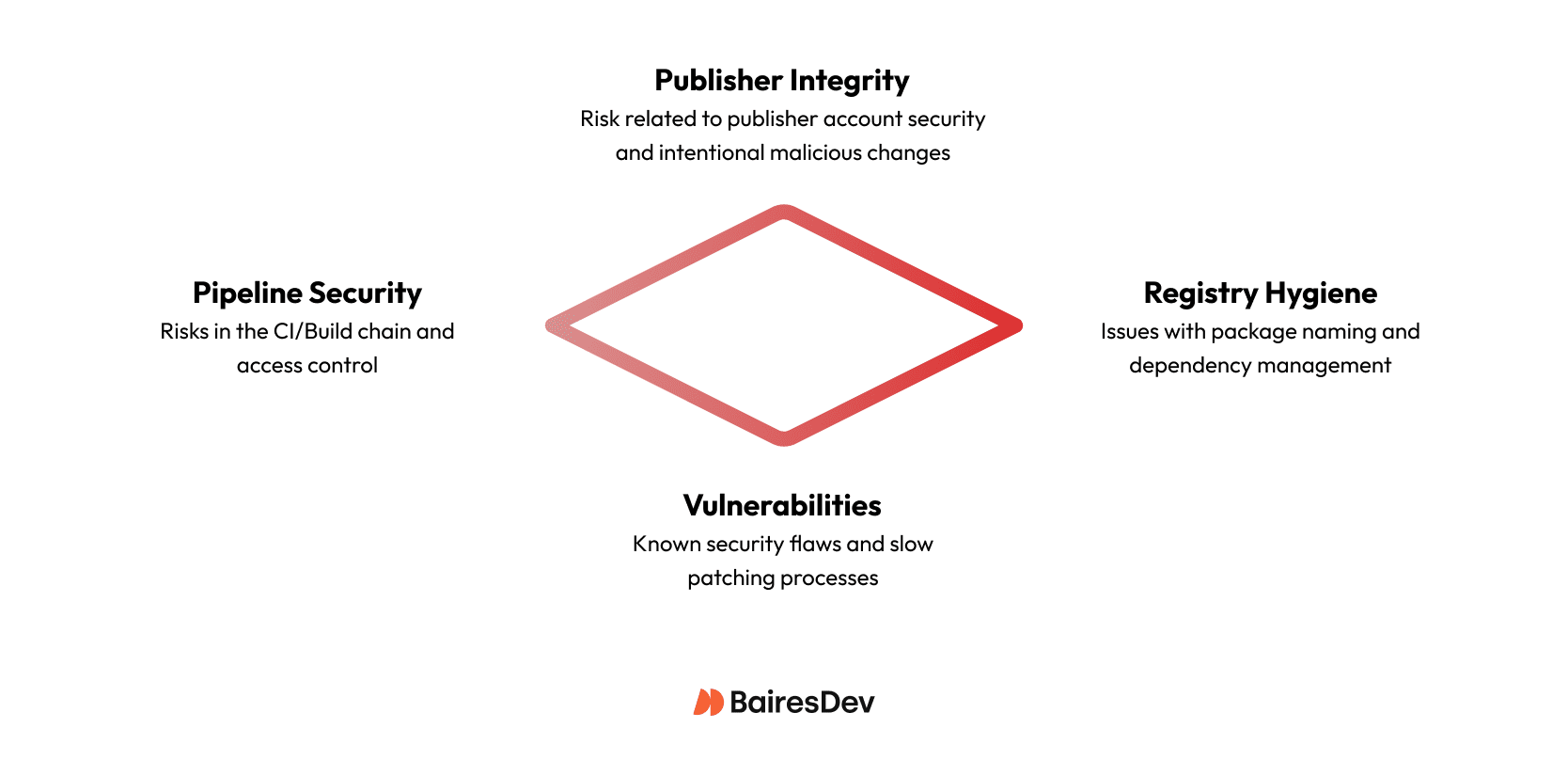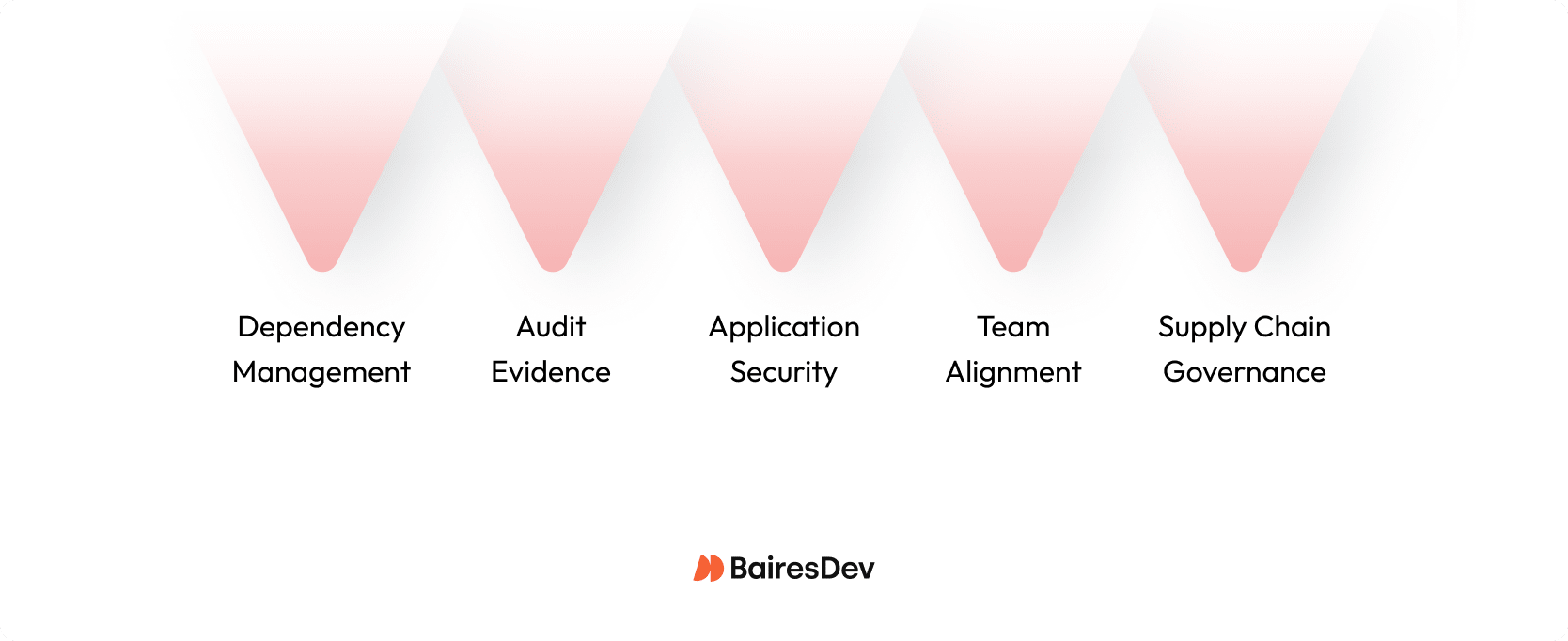Nearly every enterprise platform relies on open source software (OSS), which drives innovation but can also introduce hidden risks. Overlooked dependencies may disrupt delivery and reduce audit confidence.
The open source ecosystem includes over 100 million active repositories powering most digital products. As usage grows, so does the need for rigorous security management.
For engineering teams, maintaining open-source security best practices is now critical to protecting delivery velocity and the compliance posture.
Open Source Security Risks in 2025

Synopsys’s 2025 Open Source Security and Risk Analysis found that 97 percent of applications use open source components, and 86 percent contain known vulnerabilities. This expanding reliance elevates supply chain security to an executive-level priority.
Security engineers and developers juggle delivery speed with governance. Under SOC 2, ISO 27001, NIST, and HIPAA’s Technical Safeguards, every dependency becomes evidence. A typical microservice stack includes hundreds of third-party modules, each of which may pose exposure. Managing dependencies well is now a differentiator.
From Liability to Strategic Asset
Stop treating open source merely as free code. It is a supply chain. When ignored, it’s a liability, but properly managed, it becomes the backbone of high-velocity delivery. Procurement teams and enterprise buyers know this. They now demand proof of dependency oversight alongside your SOC 2. If you can’t prove control, you don’t close the deal.
The real strategic asset is the open-source tooling that automates your governance. Leading engineering teams leverage projects like Open Policy Agent (OPA) to decouple compliance from code and Sigstore to automate supply chain integrity.
IBM’s 2025 data confirms the ROI: extensive automation doesn’t just save an average of $1.9 million per breach. It also shortens lifecycles by 80 days.
By aligning with standards from the OpenSSF and Linux Foundation, you stop reinventing the wheel. Effective governance turns security from a bottleneck into a verifiable competitive advantage, allowing you to ship faster than shops still managing dependencies by spreadsheet.
Effective governance turns open source security from a liability into a competitive differentiator.
What if Open Source Turns Against You?
The OSS ecosystem is indispensable yet unpredictable. But what happens when something goes wrong?
Registries such as npm, PyPI, and Maven Central deliver thousands of updates daily. While this accelerates delivery, it also increases exposure if dependencies are not continuously monitored. Each dependency extends the chain of trust. Many critical packages are maintained by only one or two volunteers, often with limited bandwidth.
In regulated sectors, this presents measurable risk. Incidents such as ua-parser-js (2021), node-ipc (2022), and Shai Hulud (2025) show how quickly trusted code can be compromised.
Even minor oversights may surface months later in production. Snyk’s Open Source Security Report 2025 found that many enterprise environments still carry long-lived vulnerabilities across multiple release cycles. These unpatched issues create technical debt that often remains hidden until it impacts availability or compliance.
ISO 27001 Annex A.8 requires supplier evaluation, and SOC 2 CC6 calls for continuous vulnerability management. Without clear visibility into dependencies, controls are hard to prove or defend.
Addressing these concerns early prevents downstream vulnerabilities and audit exceptions.
From Innovation to Exposure
A decade ago, few teams tracked dependency versions beyond spreadsheets. Today, unmanaged integration can still cause disruption, as each repository, container, and pipeline increases exposure when ownership is unclear.
Developers balance speed with accountability by making secure open source practices part of daily workflows. Adhering to best practices and applying consistent controls improves both delivery efficiency and audit readiness.
Cross-functional alignment among delivery managers, environment engineers, and security leads ensures consistent controls. Many enterprises form internal working groups modeled on the OpenSSF to sustain secure coding practices and preserve institutional knowledge. These forums make security a shared design principle rather than a separate task.
Together, developers and software developers align on shared standards that protect both functionality and delivery speed.
Healthy engineering cultures embed secure-by-design defaults into the developer experience. IDE plug-ins display vulnerability data at commit time, and pre-merge hooks block unsafe versions. Integrating feedback into workflows enables developers to address issues early and maintain high velocity.
Transparency is only part of the challenge. Understanding where exposures exist and how they change enables reliable governance across software portfolios.
Secure development practices reduce exposure without slowing innovation.
Where the Exposures Hide
| Risk Mode | Example Behavior | Impact on Controls |
| Known CVEs | Patches delayed beyond SLA | SOC 2 / ISO non-conformance |
| Protestware | Maintainer injects malicious payload | Incident response required |
| Typosquatting | Look-alike packages infiltrate repos | Supplier vetting failure |
| License Drift | GPL libraries in proprietary apps | Legal and reputational threat |
| Abandonment | No updates > 24 months | Lifecycle management failure |
Shorter dependency chains and early alerts make a measurable difference. Automated checks, combined with human review, identify issues before release and provide auditors with clear evidence of oversight. Hidden exposures, especially in transitive modules, quietly weaken a company’s overall posture.
Past incidents like Log4j or node-ipc remind leaders that even trusted open-source projects can create long-term risk when transparency fades and flag vulnerable transitive dependencies early.
Gaining Traceability Through SBOMs
Unseen assets cannot be managed. A Software Bill of Materials (SBOM) documents each library’s origin, license, and version, supporting audit readiness under ISO 27001 A.12 and SOC 2 CC6.6.
CycloneDX and SPDX generate SBOMs within CI/CD pipelines, logging changes and improving traceability with minimal manual effort. These inventories serve as dynamic maps of software health. They also track third-party and open-source components across builds.
SBOMs now play a pivotal role in application security by enabling teams to validate dependencies and respond faster to emerging risks. The OpenSSF and Linux Foundation recognize SBOMs as fundamental to software and source security. Mature enterprises validate SBOMs across environments to ensure reliable code and maintain strong audit evidence throughout the lifecycle.
SBOMs are also becoming a regulatory expectation, and should be an expectation from vendors, too.
U.S. federal agencies and major cloud providers now require them during vendor onboarding. In incident response, a live SBOM reduces triage time by instantly identifying affected components, aiding both recovery and audit defense.
Teams that deploy SBOM automation across pipelines gain visibility into every dependency and accelerate secure updates. Those with current SBOMs can trace exposure within minutes during a zero-day disclosure, while others are left searching without direction.
Traceability transforms complexity into control.
Detection, Policy, and Control
| Category | Example Tools | Purpose |
| Composition Scanning | Snyk · OWASP Dependency-Check | Detect vulnerabilities and license drift |
| SBOM Automation | CycloneDX · SPDX | Generate verifiable inventories |
| Policy Enforcement | Open Policy Agent | Define rules for continuous assurance |
Embedding automated tools in pipelines ensures consistent policy enforcement across projects. Each commit is scanned before merging, and scan logs, SBOM IDs, and approvals are recorded as evidence for users and auditors.
Machine-driven checks don’t guarantee coverage. ISO 27001 A.15 and SOC 2 CC4 require supplier oversight and review. Combining governance workflows with periodic validation ensures policies actually work.
This discipline keeps custom code reliable and creates repeatable proof that strengthens the enterprise’s overall security posture.
Scaling Remediation Without Slowing Delivery
Identifying issues is only part of the process. Resolving them quickly is equally important.
Manual patching cannot keep pace. Automated workflows such as Dependabot and Renovate open pull requests for known issues, allowing teams to focus on higher-value work.
The Veracode State of Software Security 2025 found that teams resolving flaws quickly reduce critical debt by up to 75 percent, demonstrating that speed directly limits exploit risk. Treating MTTR as a service-level metric makes protection predictable rather than reactive. Addressing open-source vulnerabilities demonstrates operational maturity and keeps compliance aligned with delivery objectives.
Platform teams still need judgment. They prioritize fixes by business impact, coordinate with audit leads, and document results to keep evidence current. Done right, this rhythm builds resilience and keeps projects moving.
Modern dashboards visualize MTTR and patch age across portfolios. As leaders observe declining exposure trends, they can clearly justify investment, resulting in less downtime, fewer emergency sprints, and lower incident probability. Coordinating fixes across engineering and audit teams ensures governance remains practical and measurable.
Continuous validation and dependency tracking protect delivery speed and audit readiness.
Evidence That Stands Up to Audit
Auditors require proof of continuous controls. Integrating logs, SBOMs, and pipeline records into development makes audit readiness an inherent part of engineering.
Security engineers and auditors both rely on verifiable artifacts to demonstrate that controls are active and effective.
Oversight must include both community and internal builds. Source-analysis tools that review source code, custom code, and dependencies provide complete assurance, while signed commits confirm authorship of code.
Artifacts, including logs, SBOMs, and approvals, are automatically uploaded to a secure repository, ready for sampling. A cloud enterprise found that continuous evidence reduced audit prep time in half by embedding documentation into daily pipelines rather than running ad hoc audits. The payoff was not just efficiency but confidence.
The Organizational Model That Works
Clarify internal ownership, set measurable improvement targets, and empower teams to review and fix dependencies proactively. Integrate security practices into every phase of development to achieve both compliance and resilience.
Cross-functional coordination reveals weak points early. Shared dashboards and working groups translate lessons learned into repeatable methods. This model aligns with ISO 27001 Clause 9 and SOC 2 monitoring principles while supporting efficient delivery.
Clear lanes reduce fire drills and exceptions, while leadership gains measurable reliability. Most enterprises achieve operational dependency governance within two quarters once CI/CD pipelines and monitoring are in place, followed by continuous improvement.
Business Impact and ROI
| Outcome | Engineering Effect | Business Benefit |
| Continuous SBOMs | Less manual prep | Faster audits |
| Policy-as-Code | Blocks non-compliant builds | Fewer findings |
| Automated Updates | Lower MTTR | Reduced exploit probability |
| Centralized Metrics | Unified traceability | Quantifiable ROI |
Organizations that adopt these practices experience faster audits and fewer critical vulnerabilities per release. Stronger governance increases trust and shortens procurement cycles.
Continuous checks and secure open source software practices reduce open source vulnerabilities across projects while helping engineering teams stay ahead of emerging threats.
Sustaining the Ecosystem
Every enterprise relies on critical open-source projects, yet few contribute in return. Long-term stability requires shared responsibility. Many teams allocate time for upstream maintenance, bug triage, or documentation. These contributions enhance coordination and reliability across the ecosystem.
Beyond altruism, the benefits are tangible: fewer surprises from abandoned packages, faster patch availability, and smoother interoperability across tools. Participation in security response groups or code review efforts builds knowledge that developers bring back into internal pipelines.
By contributing code and maintenance to upstream projects, organizations reinforce essential projects. Enterprises that join and participate discover new features earlier, anticipate dependency changes, and reduce integration friction. Collective stewardship transforms unmanaged exposure into a measurable benefit and demonstrates that modern software health relies on shared accountability.
Efforts from the Linux community and OpenSSF illustrate this focus on resilience.
What Good OSS Security Looks Like
Mature programs achieve assurance by design. Developers commit verified code, automated workflows validate authenticity, and SBOMs update in real-time. Governance remains visible throughout delivery.
Practical evidence includes regular internal audits, controlled access reviews, dependency-aging reports, and verification of policy exceptions. These repeatable routines integrate standards alignment into daily engineering rather than limiting it to annual reviews. Such discipline is essential for maintaining software integrity at scale.
These repeatable processes ensure reliable functionality across systems and preserve posture during every deployment. When governance and engineering align, assurance becomes part of the culture.
BairesDev’s Perspective
BairesDev helps organizations turn dependency exposure into verifiable trust. Our engineers integrate composition analysis, policy control, and SBOM workflows directly into client pipelines, establishing a feedback loop between governance and delivery. This approach turns compliance into a competitive advantage. We also contribute upstream and support numerous open-source software projects.
Looking ahead, BairesDev is exploring predictive governance that correlates maintainer activity with vulnerability feeds. These capabilities help enterprises anticipate exposure before disclosure, advancing continuous protection and readiness.
Strategic Takeaways

- Treat every dependency as a supplier and continuously monitor it.
- Combine automated workflows and oversight to produce living audit evidence.
- Apply secure practices to both open and internal applications.
- Align security, infrastructure, and audit teams for unified outcomes.
- Strengthen supply chain governance to keep innovation ahead of emerging threats.
For engineering leaders balancing delivery with assurance, the path forward is clear: treat security governance as an enabler, not an obstacle. When coordination and continuous governance work in rhythm, secure software becomes the default, enabling innovative solutions at the speed of trust.






